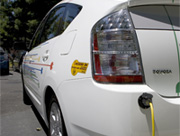Sunday, June 24th, 2007
David Lazarus of the SF Chronicle agrees with my assessment of the recent CAFE mileage-standards revision in the Senate:
“This is a good day for American consumers and the environment, since we finally have gotten on the right path to better fuel economy,” said California Sen. Barbara Boxer.
Joan Claybrook, president of Public Citizen, saw things differently. “This is not a win, nor is it a step forward for fuel economy, consumers or the environment,” she said.
Claybrook was former administrator of the National Highway Traffic Safety Administration. Read more of her comments on the new CAFE standards.
There’s more of the Lazarus piece that’s worth reading:
Dave McCurdy, president of the Alliance of Automobile Manufacturers, an industry group, called the goals of HR6 [a more aggressive version of the bill that finally passed] “wildly extreme,” and said such ambitious fuel-efficiency standards “would eliminate some of the most popular vehicles on the road today and devastate both consumer choice and the auto industry.”
Probably not. What they’d do is compel Detroit to produce vehicles that reflect this nation’s increasingly precarious energy security and send a message to overseas oil producers that we no longer intend to dance to their tune.
Significantly higher fuel-efficiency requirements would also prompt engineers in Detroit and in universities nationwide to do what this country has always done better than all other countries — innovate.
 In more positive news about reducing oil consumption, Google .org (the philanthropic arm of Google, Inc) has given $1 million in grants to promote use of plug-in hybrids. Here are the grant recipients.
In more positive news about reducing oil consumption, Google .org (the philanthropic arm of Google, Inc) has given $1 million in grants to promote use of plug-in hybrids. Here are the grant recipients.
Google.org has pledged another $10M to to fund development, adoption and commercialization of plug-ins, fully electric cars and related vehicle-to-grid (V2G) technology.
Tags: hybrid, mileage, google, cafe
posted to channel: Conservation
updated: 2007-06-24 16:45:17
Saturday, June 23rd, 2007
It’s a fruit year. Every tree in the orchard set fruit this year — lemon, peach, apricot, apples, asian pear, persimmon, plum, fig, and whatever this thing is.
I was walking near the bottom of the property with Raphael. This is sort of a novelty because we just had the grass cut (using the term “grass” charitably here); for the first time in three months we can actually walk across the yard without a machete to hack our way through the overgrowth. At two and a half years, Raphael likely has no memory of what our back yard normally looks like.
At age 40, I don’t either. But then I don’t get out much.
Anyway we found three trees we’d never seen before. All three are covered in small yellow-orange fruit. We don’t know what it is.
If you recognize it, let me know. Maybe I’ll send you a pie.
Update 2007-07-05: We figured it out.
Tags: fruit, orchard, mystery
posted to channel: Personal
updated: 2007-07-05 18:27:36
Friday, June 22nd, 2007
Excerpt from a campaign update from my favorite eco-charity, the Union of Concerned Scientists:
Late last night the Union of Concerned Scientists and our allies won a major victory on fuel economy! Thanks in part to your numerous emails and phone calls, the Senate voted yesterday to substantially increase the corporate average fuel economy (CAFE) standard of America’s cars and trucks for the first time in over 30 years — setting a target of 35 miles per gallon by 2020.
I’m all for raising CAFE standards, but this sounds like a pretty feeble compromise. I drove a car in 2004 — nearly 3 full years ago — that measured 53.9 mpg over a 4-5 hour commute. Yet in 13 more years, the best average our politicians are willing to demand is 35 mpg?
I suppose what makes this newsworthy is, as noted above, that the numbers have moved at all. The original CAFE standards were proposed in 1975 (when the average fleet mileage was apparently a dismal 14 mpg) and never amended, except for a period in the late 1980s when mileage minimums were lowered. Detroit, you go girl!
Tags: mileage, congress, bah
posted to channel: Conservation
updated: 2007-06-22 23:34:33
Thursday, April 26th, 2007
Just need to say that this is blowing my mind, and I’m seriously thinking about disabling the locking mechanism on my oven door.
Tags: pizza
posted to channel: Food & Cooking
updated: 2007-04-28 12:51:27
Wednesday, April 25th, 2007
It used to be true that the best way to spend money in a foreign country was via credit card, because the credit companies offered fair exchange rates, and the cards themselves avoided the risks of carrying cash, not to mention the problems associated with exchanging cash at storefronts whose reputations for fairness are not known. But over the past few years, credit companies and the card-issuing banks alike have begun adding sizeable fees for foreign-currency transactions, or in some cases, for any foreign transactions (even when no currency conversion is required).
The fees vary widely, so if you’re planning a trip, it pays to call your various card providers to ask what their fees are. For example, here’s what I learned:
| Card type | Currency exchange fee |
| platinum Visa | 3% of transaction amount or $10, whichever is higher |
| airline miles Visa | 3% of transaction amount |
| debit (ATM) card | 1% of transaction amount |
The $10 minimum fee on my platinum Visa was a real shock. But even beyond that, there’s a 3x difference in transaction fees just for the cards I carry.
The following article is dated, but its conclusions still seem relevant: Abroad, not all plastic is created equal
Tags: visa, currency, fees
posted to channel: Travel
updated: 2007-04-25 16:51:43
